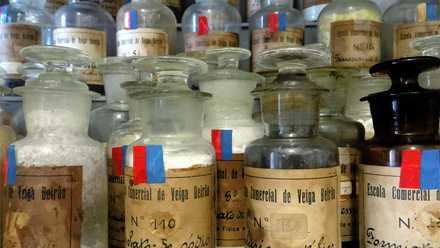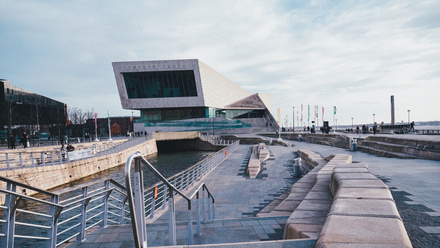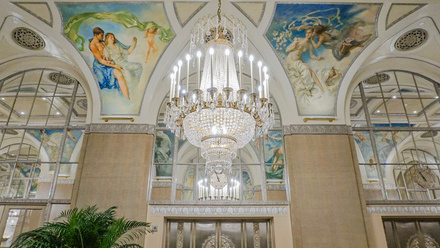Please join us for our annual AGM followed by presentations on the theme of 'A Project I am Proud Of'.
Presentations and Speakers:
- Waste free and economical conservation storage of medieval stained glass in the National Trust by Laura Mountford, English Heritage
The most challenging part of a wider project to improve the storage of the most sensitive archaeological materials from Lacock Abbey, Wiltshire, was the re-housing of approximately forty fragments of early Medieval stained glass. The glass had previously been collectively stored in an archaeological finds bag and was at risk of damage. With a very limited budget for the entire project, a creative solution was needed to safely store the glass within the available time and resources. The fragments also needed to be accessible to specialists for future study, adding a further challenge: that of ease of access to the collection. Perfectly fitting Plastazote cut-outs to cradle the glass would have been preferable, but very time consuming to do in-house and more expensive in terms of staff time. After much thought and, later, inspiration from the Sustainability in Conservation network (SiC), I decided to lay the fragments onto a layer of Plastazote and to use strips of Plastazote off-cuts, held in place with entomology pins around the fragment to keep each in place. Off-cuts of acetate were also placed over each piece of glass and pinned down to help keep dust particles off the surfaces. The glass is easily freed and removed for research by taking away the pins, maybe even more so than if they had been placed into purposefully sunken supports. The fragments, as a result of creative thinking, are now well organised, stable and ready for study by a project researcher.
- A study of the readability of humidity indicator cards and the implication for the storage of archaeological metals by Seren Kitchener, Cardiff University
Humidity indicator cards are widely used throughout the heritage sector, as an instrument to monitor the relative humidity of museum environments and microclimates, and therefore are one of the first things to indicate a problem. Humidity indicator cards rely on being accurately read to be effective. They indicate a change of relative humidity (RH) by changing colour, often from a blue to pink. Therefore, the colour perception of an individual reading the card, amongst other variables, may affect how accurately a humidity indicator card is read and recorded. If cards are read inaccurately, it may have a detrimental effect to the objects in that environment. This is particularly the case for iron, which can be dramatically affected by small changes in RH and ideally needs to be stored at an RH between 30% and 50%, but sometimes even below 15% RH for actively corroding iron. The risk of corrosion and damage to an iron object rises dramatically past 30% relative humidity, so accurate reading is necessary to ensure it is stored in an adequate environment. This study investigated the readability of different humidity indicator types, and the variables that may affect an individual’s ability to read them. The study was informed using a questionnaire dispersed to the sector, which tested participant’s ability to read different humidity indicator cards. This paper represents the results of said questionnaire and explores whether an individual’s level of experience and training affects a person’s ability to accurately read a humidity indicator card. The findings form a basis for recommendations, including that 6 spot humidity indicator cards are the most accurately read of those tested, and are easily readable for individuals of differing backgrounds and variables.
- The conservation of an iron artefact assemblage from Ferrycarrig by Eleanor Evans, Cardiff University
Whilst studying for my MSc Conservation Practice at Cardiff University (2018-2020), I worked on an assemblage of iron artefacts from the Irish Archaeology Field School (IAFS). The assemblage consisted of 52 iron artefacts, which had been excavated in 2018 in Ferrycarrig (near Wexford). This was the first archaeological assemblage I had conserved, so organising my time and carrying out the stages of analysis and treatment was all carefully planned out.
I was in regular contact with the owner of the objects at the IAFS and discussed what their needs were and created a list of 14 priority objects.
I started by preparing a spreadsheet to record information about the treatments carried out on the artefacts; X-ray was used for analysis, air-abrasion was utilised for the removal of the ‘transformed layer’ corrosion from a number of these artefacts, and then the iron objects were consolidated using the vacuum chamber.
There were some ups and downs along the way during this project and, unfortunately, I never got to complete the project as the campus closed in March 2020 because of COVID-19.
- 3D replicas of Clachtoll Broch assemblage by Marta Pilarska, AOC Archaeology
AOC Archaeology, in partnership with Historic Assynt, has been involved in the excavation and conservation of Clachtoll Broch and the associated finds since 2017. During archaeological works at Clachtoll, an abundance of material was discovered, revealing artefacts not seen by the human eye for over two millennia!
AOC’s post-excavation and conservation teams have been working on interpretation and analysis of this assemblage, identifying individual objects and shedding the light on the stories behind them.
During one of the final stages of the project, AOC’s digital heritage team worked on 3D documentation and replication of the selection of artefacts. A range of objects – from pottery and stone to bone, were selected for high-resolution 3D recording. Using photogrammetry, we were able to create digital replicas of objects excavated at Clachtoll Broch. This is helping to enable visitors to develop a more personal connection with places and history and is making heritage more inclusive and accessible for people with visual impairments.
- Roman insects also like eating nice objects: the investigation of ancient pest damage on a Roman leather object by Luisa Duarte, Museum of London
In 2012, a large, decorated, multi-layered, flat leather object was discovered during the excavation at Bloomberg Place, London. The object presented several interesting conservation challenges, as well as surprising evidence of ancient pest damage.
I stabilised the waterlogged object using a glycerol immersion treatment followed by freeze drying. After drying, I used a paper conservation technique to gently humidify and flatten the layers of the object and backed fragile areas with Reemay.
During conservation, I discovered a large amount of ancient insect damage, and decided to map each instance of damage in each layer. The nature and position of the damage allowed me to suggest the likely construction of the object and provided the specialist with further clues regarding its possible use during the Roman period.
This project is particularly close to my heart, as the conservation of a stunning object turned into an interesting months-long investigation.
Each presentation will be about 10 minutes, followed by time for questions. Abstracts will be added to our Group Members' Area soon, please ensure you are logged in to the Icon website to view this section.



